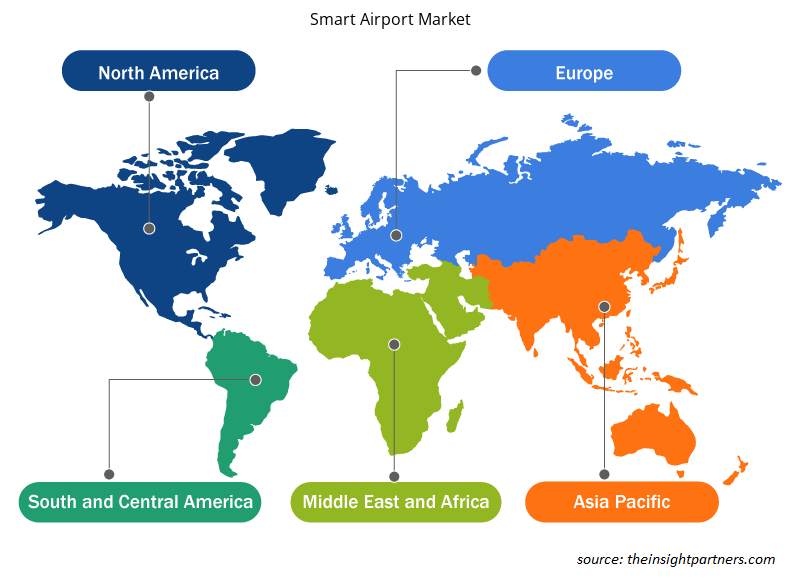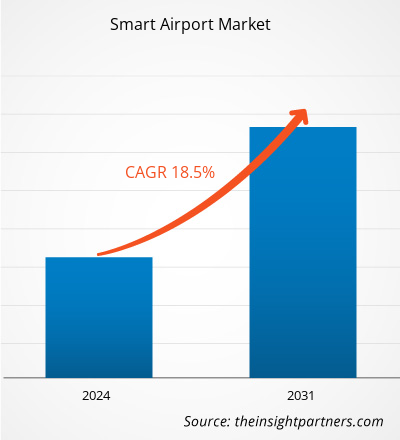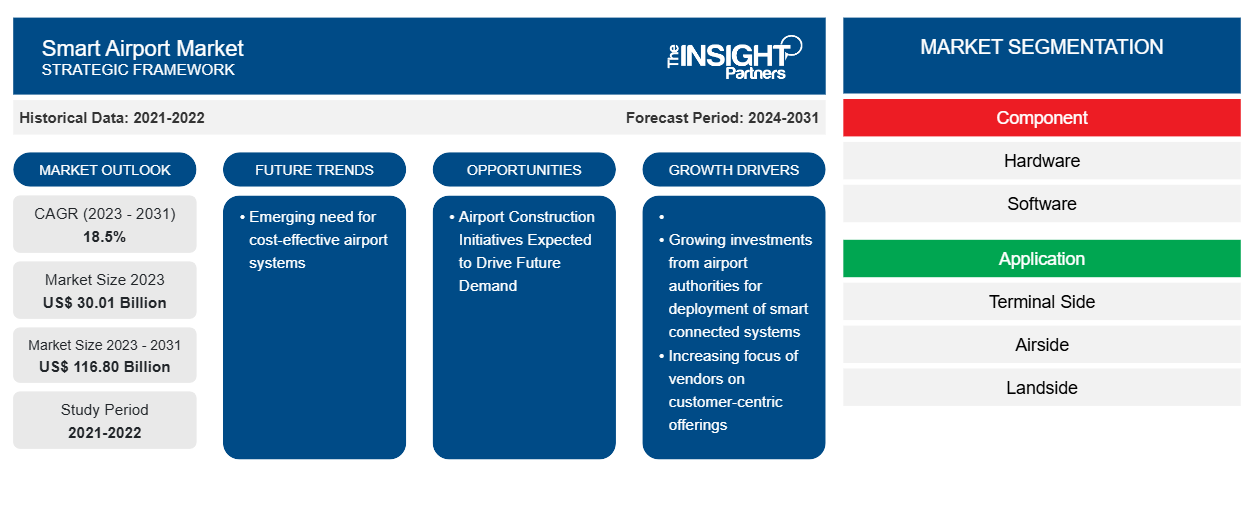Le marché des aéroports intelligents devrait atteindre 116,80 milliards USD d'ici 2031, contre 30,01 milliards USD en 2023. Le marché devrait enregistrer un TCAC de 18,5 % au cours de la période 2023-2031. Le besoin croissant de systèmes aéroportuaires rentables devrait rester une tendance clé du marché.
Analyse du marché des aéroports intelligents
Les aéroports s'approvisionnent en solutions et services auprès des fabricants de systèmes aéroportuaires intelligents. La demande de systèmes automatisés pour les aéroports intelligents augmente en raison des investissements croissants dans le déploiement de systèmes basés sur l'IA et le ML dans différents aéroports. Les fabricants de composants de l'écosystème des aéroports intelligents ont signé des contrats à court et à long terme avec les fabricants d'appareils technologiques intelligents, tels que des systèmes intelligents de traitement des données , des biométries d'intelligence artificielle , des capteurs IoT , des modems, des routeurs et des capteurs à décoller et à coller.Amadeus IT Group SA ; Cisco System, Inc ; Huawei Technologies Co., Ltd ; Honeywell International Inc. ; Indra Sistemas SA ; SABRE GLBL Inc. ; Jeppesen ; Zensors ; et SITA sont les fournisseurs de systèmes aéroportuaires intelligents. Ces entreprises fournissent des appareils, des services et des solutions intelligents de bout en bout aux utilisateurs finaux ciblés. Les principaux utilisateurs finaux de systèmes aéroportuaires intelligents sont les aéroports de Singapour Changi , de Séoul Incheon , de Houston, de Tokyo Haneda , de Hong Kong International Airport, de Doha Hamad International Airport, de Munich Airport et de Londres Heathrow .
Aperçu du marché des aéroports intelligents
Les principaux acteurs de l’écosystème du marché des aéroports intelligents sont les fabricants et fournisseurs de composants, les développeurs et intégrateurs de logiciels , les fabricants de systèmes d’aéroports intelligents et les utilisateurs finaux. Parmi les fabricants et fournisseurs de composants figurent Astronics Corporation, TE Connectivity, Molex , Panduit , Honeywell et Schneider Electric, entre autres. L’augmentation des investissements gouvernementaux dans la mise en place d’aéroports intelligents accélère la numérisation des aéroports. La sécurité est cruciale dans les aéroports intelligents ; ainsi, de nombreuses autorités aéroportuaires intelligentes travaillent ensemble pour sécuriser ces installations et améliorer leur efficacité opérationnelle.
Personnalisez ce rapport en fonction de vos besoins
Vous bénéficierez d'une personnalisation gratuite de n'importe quel rapport, y compris de certaines parties de ce rapport, d'une analyse au niveau des pays, d'un pack de données Excel, ainsi que d'offres et de remises exceptionnelles pour les start-ups et les universités.
-
Obtenez les principales tendances clés du marché de ce rapport.Cet échantillon GRATUIT comprendra une analyse de données, allant des tendances du marché aux estimations et prévisions.
Facteurs moteurs et opportunités du marché des aéroports intelligents
L'attention croissante des fournisseurs du marché aux offres centrées sur le client
Les entreprises du secteur des aéroports intelligents se concentrent sur la fourniture de solutions centrées sur le client pour stimuler l'adoption des technologies des aéroports intelligents. La demande des passagers en matière de suivi des bagages est en hausse dans le monde entier, ce qui constitue l'un des principaux domaines d'intérêt des autorités aéroportuaires. Selon l'Administration de l'aviation civile de Chine ( CAAC ), en 2021, environ 75 % des passagers aériens en Chine souhaitaient connaître les détails du suivi de leurs bagages et l'heure de récupération. Selon la même étude, environ 86 % des compagnies aériennes en Chine se concentrent sur la fourniture de notifications de suivi des bagages, et 57 % des compagnies aériennes fournissent également des informations sur la récupération des bagages à leurs passagers dans toute la Chine. Ainsi, les fournisseurs du marché des aéroports intelligents se concentrent sur la fourniture de systèmes intelligents de gestion des bagages des compagnies aériennes aux compagnies aériennes pour automatiser leurs opérations commerciales et offrir une meilleure expérience aux passagers. Ces systèmes sont intégrés aux applications et bases de données des compagnies aériennes basées sur le cloud, aux analyses basées sur le cloud et à une plate-forme machine-to-machine (M2M) et IoT pour connecter, gérer et sécuriser les données et événements en temps réel des bagages intelligents. De plus, le déploiement de systèmes de gestion des bagages dans les aéroports contribue également à réduire les coûts opérationnels globaux, tout en augmentant l’efficacité opérationnelle globale.
Projets de construction de nouveaux aéroports
L'augmentation du nombre de projets de construction d'aéroports dans les pays émergents tels que la Chine et l'Inde est susceptible de générer de nouvelles opportunités pour les fournisseurs du marché dans les années à venir. Plusieurs plans gouvernementaux liés à la construction de nouveaux aéroports et à l'expansion/à la modernisation des aéroports existants sont d'autres facteurs majeurs susceptibles de soutenir le déploiement de systèmes aéroportuaires intelligents dans les années à venir. Par exemple, le gouvernement indien a déjà annoncé en 2022 son intention de construire 220 aéroports d'ici fin 2025. De plus, en 2018, l'Administration de l'aviation civile de Chine ( CAAC ) a annoncé son intention de construire 216 nouveaux aéroports d'ici fin 2035, ce qui porte le nombre total d'aéroports à 450 d'ici 2035 (234 aéroports actuellement en 2023). De tels projets sont susceptibles de générer de nouvelles opportunités pour les entreprises de technologie aéroportuaire intelligente dans les années à venir.
Analyse de segmentation du rapport sur le marché des aéroports intelligents
Les segments clés qui ont contribué à l’élaboration de l’analyse du marché des aéroports intelligents sont les composants et les applications.
- En fonction des composants, le marché des aéroports intelligents est divisé en matériel et logiciel. Le segment du matériel est lui-même divisé en systèmes de sécurité, systèmes de communication et de navigation, terminaux et systèmes de stockage de données. Le segment du matériel détenait une part de marché plus importante en 2023.
- En fonction des applications, le marché des aéroports intelligents est segmenté en terminaux, en pistes et en pistes. Le segment des terminaux détenait une part de marché plus importante en 2023.
Analyse des parts de marché des aéroports intelligents par zone géographique
La portée géographique du rapport sur le marché des aéroports intelligents est principalement divisée en cinq régions : Amérique du Nord, Europe, Asie-Pacifique, Moyen-Orient et Afrique et Amérique du Sud.
L'Asie-Pacifique a dominé le marché en 2023, suivie de l'Europe et de l'Amérique du Nord. En outre, l'Asie-Pacifique devrait connaître le TCAC le plus élevé dans les années à venir. Le principal moteur du marché des aéroports intelligents en Asie-Pacifique est la présence d'un grand nombre de projets d'aéroports intelligents dans la région. Par exemple, certains des principaux aéroports intelligents situés dans la région Asie-Pacifique sont l'aéroport international de Hong Kong, l'aéroport de Shenzhen, l'aéroport international de Pékin-Daxing, l'aéroport de Tokyo-Haneda, l'aéroport international Centrair de Nagoya, l'aéroport international de New Delhi, l'aéroport international d'Hyderabad, l'aéroport de Séoul-Incheon, l'aéroport de Jeju, l'aéroport de Singapour-Changi, l'aéroport international de Kuala Lumpur et l'aéroport d'Indonésie. De plus, des pays comme la Chine et l'Inde devraient construire plus de 400 aéroports d'ici la fin de 2035, ce qui devrait encore stimuler le marché dans les années à venir.
Aperçu régional du marché des aéroports intelligents
Les tendances et facteurs régionaux influençant le marché des aéroports intelligents tout au long de la période de prévision ont été expliqués en détail par les analystes d'Insight Partners. Cette section aborde également les segments et la géographie du marché des aéroports intelligents en Amérique du Nord, en Europe, en Asie-Pacifique, au Moyen-Orient et en Afrique, ainsi qu'en Amérique du Sud et en Amérique centrale.

- Obtenez les données régionales spécifiques au marché des aéroports intelligents
Portée du rapport sur le marché des aéroports intelligents
| Attribut de rapport | Détails |
|---|---|
| Taille du marché en 2023 | 30,01 milliards de dollars américains |
| Taille du marché d'ici 2031 | 116,80 milliards de dollars américains |
| Taux de croissance annuel composé mondial (2023-2031) | 18,5% |
| Données historiques | 2021-2022 |
| Période de prévision | 2024-2031 |
| Segments couverts |
Par composant
|
| Régions et pays couverts |
Amérique du Nord
|
| Leaders du marché et profils d'entreprises clés |
|
Densité des acteurs du marché : comprendre son impact sur la dynamique des entreprises
Le marché des aéroports intelligents connaît une croissance rapide, stimulée par la demande croissante des utilisateurs finaux en raison de facteurs tels que l'évolution des préférences des consommateurs, les avancées technologiques et une meilleure connaissance des avantages du produit. À mesure que la demande augmente, les entreprises élargissent leurs offres, innovent pour répondre aux besoins des consommateurs et capitalisent sur les tendances émergentes, ce qui alimente davantage la croissance du marché.
La densité des acteurs du marché fait référence à la répartition des entreprises ou des sociétés opérant sur un marché ou un secteur particulier. Elle indique le nombre de concurrents (acteurs du marché) présents sur un marché donné par rapport à sa taille ou à sa valeur marchande totale.
Les principales entreprises opérant sur le marché des aéroports intelligents sont :
- Honeywell International Inc
- Cisco Systems Inc
- Huawei Technologies Co., Ltd
- Indra Sistemas SA
- Groupe Amadeus IT SA
- SITA
Avis de non-responsabilité : les sociétés répertoriées ci-dessus ne sont pas classées dans un ordre particulier.

- Obtenez un aperçu des principaux acteurs du marché des aéroports intelligents
Actualités et développements récents du marché des aéroports intelligents
Le marché des aéroports intelligents est évalué en collectant des données qualitatives et quantitatives issues de recherches primaires et secondaires, qui comprennent d'importantes publications d'entreprises, des données d'associations et des bases de données. Quelques-uns des développements sur le marché des aéroports intelligents sont énumérés ci-dessous :
Thales a remporté un contrat auprès du groupe de gestion aéroportuaire SEA (Società per azioni Esercizi Aeroportuali) pour fournir une solution de plateforme numérique innovante qui aidera le groupe à améliorer son efficacité opérationnelle. (Source : Thales, Communiqué de presse, mars 2022)
- Lors du premier salon Airports Innovate, qui se déroule du 20 au 22 novembre à Mascate, Oman, Huawei a lancé une série de toutes nouvelles solutions aéroportuaires intelligentes pour les marchés internationaux, notamment la solution de réseau de fibre optique entièrement connectée et la solution de sécurité périmétrique aéroportuaire intelligente avec détection par fibre optique. (Source : Huawei, communiqué de presse, novembre 2023)
Rapport sur le marché des aéroports intelligents : couverture et livrables
Le rapport « Smart Airport Market Size and Forecast (2021-2031) » fournit une analyse détaillée du marché couvrant les domaines ci-dessous :
- Taille et prévisions du marché des aéroports intelligents aux niveaux mondial, régional et national pour tous les segments de marché clés couverts par le périmètre
- Tendances du marché des aéroports intelligents ainsi que dynamiques du marché telles que les facteurs moteurs, les contraintes et les opportunités clés
- Analyse détaillée des cinq forces du porteur
- Analyse du marché des aéroports intelligents couvrant les principales tendances du marché, le cadre mondial et régional, les principaux acteurs, les réglementations et les développements récents du marché
- Analyse du paysage industriel et de la concurrence couvrant la concentration du marché, l'analyse de la carte thermique, les principaux acteurs et les développements récents pour le marché des aéroports intelligents
- Profils d'entreprise détaillés
- Analyse historique (2 ans), année de base, prévision (7 ans) avec TCAC
- Analyse PEST et SWOT
- Taille du marché Valeur / Volume - Mondial, Régional, Pays
- Industrie et paysage concurrentiel
- Ensemble de données Excel
Rapports récents
Témoignages
Raison d'acheter
- Prise de décision éclairée
- Compréhension de la dynamique du marché
- Analyse concurrentielle
- Connaissances clients
- Prévisions de marché
- Atténuation des risques
- Planification stratégique
- Justification des investissements
- Identification des marchés émergents
- Amélioration des stratégies marketing
- Amélioration de l'efficacité opérationnelle
- Alignement sur les tendances réglementaires























 Obtenez un échantillon gratuit pour - Marché des aéroports intelligents
Obtenez un échantillon gratuit pour - Marché des aéroports intelligents